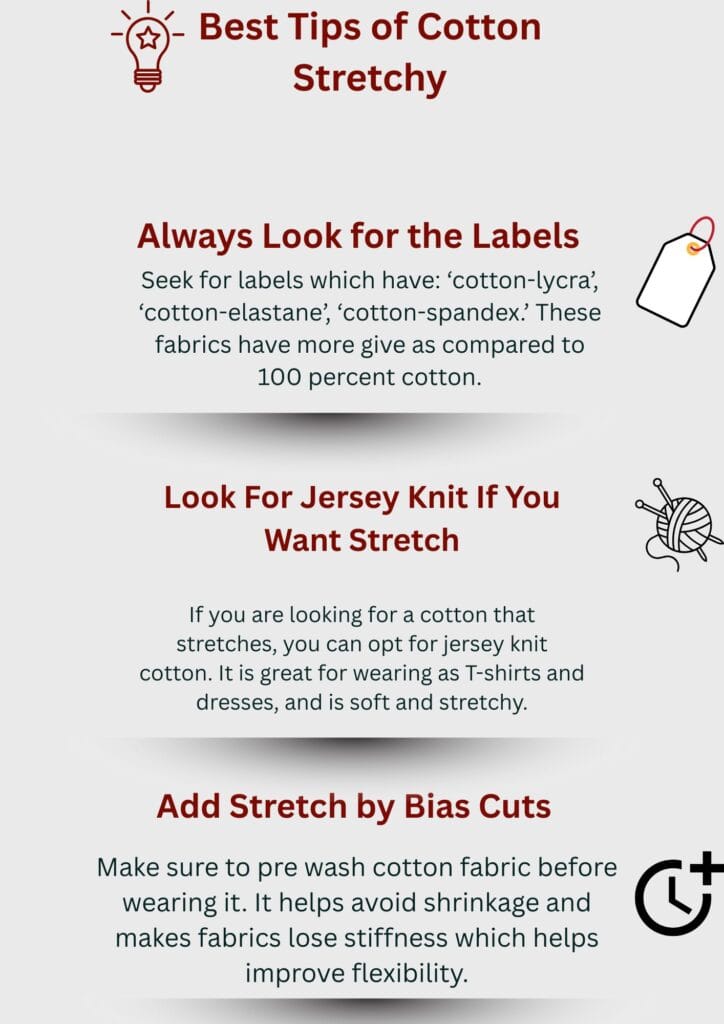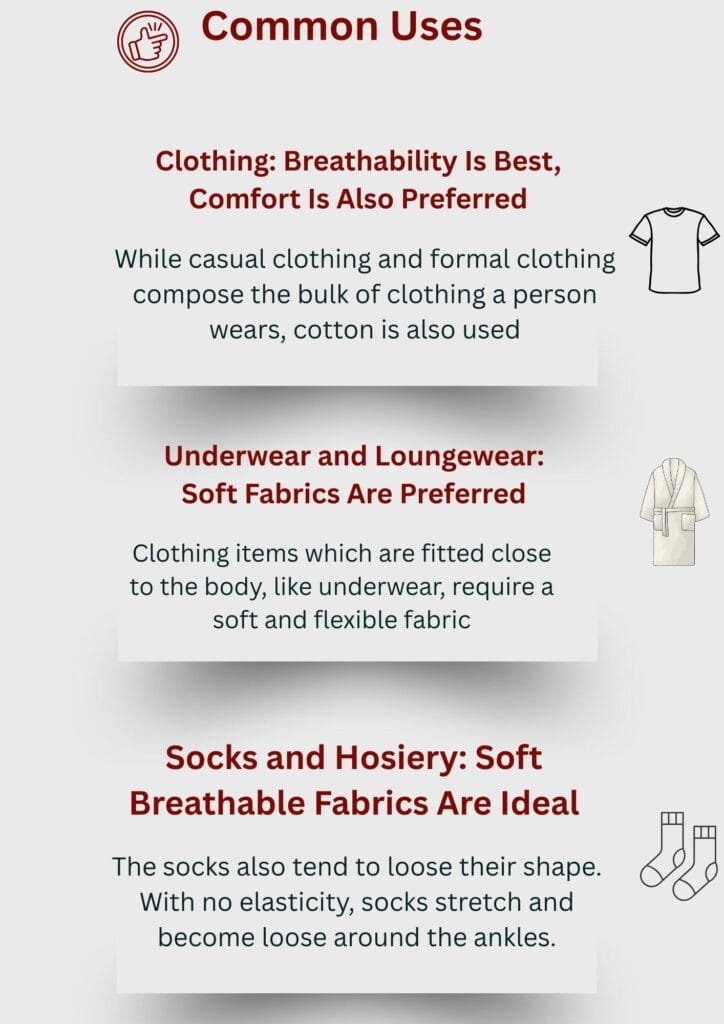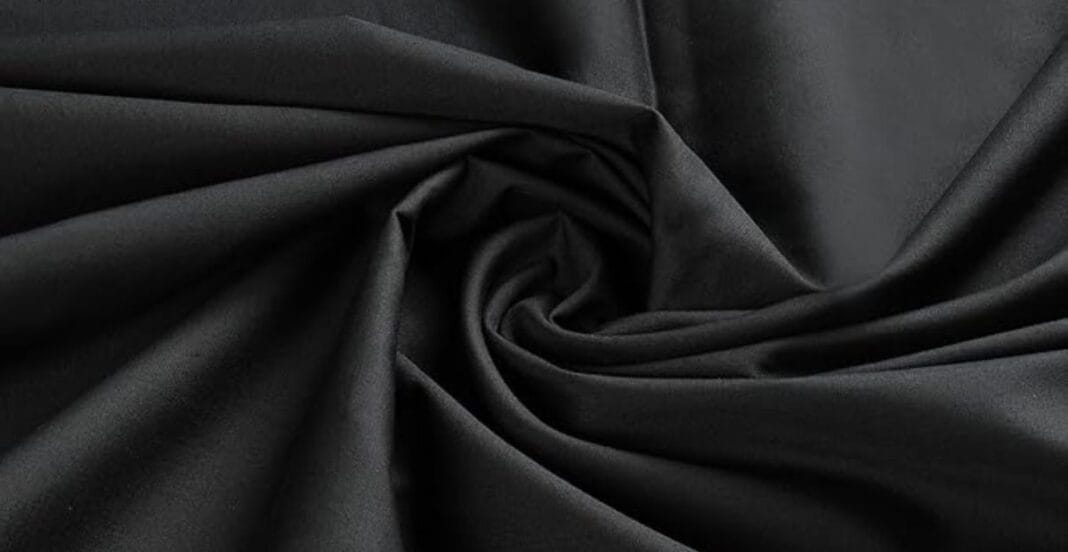Introduction
Cotton is a fabric that is expensive in the eyes of the wearer, since everyone loves to wear, use, and sleep on goods made of cotton fabric. But there is a persistent question: is cotton stretchy? This curiosity is natural due to the contrary behavior exhibited by cotton in comparison to synthetic fabrics, especially in regard to flexibility and fitting.
Cotton is present in almost all items that a person uses or requires on a daily basis. people often take it for granted expecting the fabric to stretch and fit in easily. The question is, Does it actually performs this function or is it a mental made up phenomenon?
In this article we will explore the science and styling of cotton. We’ll reveal the misnomer of stretchability of cotton and some treatments or blends which can change its flexibility. This article is an answer to the queries which arise in the wearer’s minds regarding some cotton goods fitting tighter or looser.
Core Answer: Is Cotton Naturally Stretchy?
Pure Cotton and Its Natural Fiber Structure
A cotton plant’s harvest yields pure cotton, which is a natural fiber soft in texture, breathable, and can absorb moisture. As for stretching, cotton does not possess the elastic properties like synthetic materials.
Although cotton is comfortable and breathable, it does not recover its shape easily after being deformed. The cellulose fibers in the cotton are rigid and protein like in strength, which makes them strong, but not very bendable.
Cotton As Compared To Stretchy Synthetic Fabrics
Synthetics such as spandex, elastane, or even polyester are designed to have elasticity. Unlike cotton, which stretches under pressure but lacks the ability to recover its original shape easily, these materials can stretch and return to the original shape.
Thus, for comparisons between a shirt made of 100% cotton and a shirt made of cotton and spandex blend, the difference in spacers stretch ability and stretch is astonishing. This is the reason pure cotton feels stiff or snug while cotton blend fabrics are more stretchy and form fitting.
Factors That Affect Cotton’s Stretchiness
Despite not being elastic in nature, pure cotton’s fabric stretchiness is influenced by several factors. We will examine them now:
Weaving Styles: Jersey, Twill, Poplin, and More
The weave of fabrics is intrinsic in their stretchiness. Jersey knit cotton, which is popular as T-shirt fabric, is flexible because of its looping knit structure. It is more flexible than poplin and twill weaves which are more rigid.
- Jersey: Used widely in casual wear, it is soft and stretchy.
- Twill: Diagonal weave, used in jeans and workwear. Has some give, but not true stretch.
- Poplin: Stretch very little, and is lightweight and crisp.
Looser and more flexible weaves produce fabrics that feel stretchier to some extent, even when made from pure cotton.
Fabrics With Stretch: Cotton With Spandex Or Lycra
The presence of Spandex, also referred to as elastane, and Lycra, cotton blends, increases stretchiness to a greater extent. These types of blends normally consist of 2 -5% of synthetic fibers which is ample to enhance flexibility of fabric.
These blends are also found in:
- Jeans
- Leggings
- Fitted shirts
- Athletic wear
Now, with the question “is cotton stretchy?”, the real inquiry is, is it blended or pure?
Knit vs. Woven Cotton
Knitted cotton fabrics are more flexible due to the interlocking loops used to create them. Woven cotton, on the other hand, is made perpendicular with yarns interlacing to form a more rigid structure with substantially less stretch.
Knitted cotton is commonly used for:
- T-shirts
- Baby clothes
- Stretchy loungewear
Woven cotton is often found in:
- Dress shirts
- Pants
- Bedding
Fabric Treatment: Pre-Washed or Mechanically Altered Cotton
During the production of some fabrics, pre-washing, distressing, or the use of cotton jerseys can be applied. So long as the process used allows the fibers to relax, the fabric can feel softer or stretch more.
For example:
- Pre-washed jeans feel more flexible than raw denim.
- Distressed cotton shirts are better molded to the body.
These treatments, while not adding true elasticity, do enhance feel, comfort, and stretch.
Best Tips of Cotton Stretchy

Always Look for the Labels
Seek for labels which have: ‘cotton-lycra’, ‘cotton-elastane’, ‘cotton-spandex.’ These fabrics have more give as compared to 100 percent cotton.
Look For Jersey Knit If You Want Stretch
If you are looking for a cotton that stretches, you can opt for jersey knit cotton. It is great for wearing as T-shirts and dresses, and is soft and stretchy.
Add Stretch by Bias Cuts
Sewing your own cotton garments? For these cotton garments, you can increase the natural stretch by cutting on the bias to give the garments more give without putting in synthetic fibers.
Always Wash it First to Avoid it Shrinking
Make sure to pre wash cotton fabric before wearing it. It helps avoid shrinkage and makes fabrics lose stiffness which helps improve flexibility.
Does Cotton Stretch Over Time?
Cotton can stretch within a timeframe of wear, especially after washing. Stretching, in this context however, is not the same as elasticity. Cotton may relax or become looser, but it does not rebound.
Stretching vs. Shrinking
Cotton responds to stimuli in two seemingly contrasting ways –
- It often shrinks after the first wash, particularly if hot water is used.
- It can also loosen with wear after some time, particularly in areas that move a lot, like the knees or elbows.
This natural give is not the same as the controlled stretch of a spandex blend. A cotton blend will not always return to its original state once stretched.
How to Make Cotton More Stretchy
If you’re working on a cotton garment and want to increase its elasticity, consider the following suggestions.
Choose Cotton-Spandex Blends
If you want clothing that provides comfort and freedom of movement, look for fabric labeled as:
- Cotton-spandex
- Cotton-elastane
- Cotton-lycra
Even a small proportion of synthetic fiber, 3-5 % can result in considerable improvement of the fabrics stretch ability.
Opt for Knit Cotton Fabrics
As discussed, knit fabrics generally tend to have more stretch. When sewing or shopping, look for jersey knit or interlock knit as they have the best stretch.
Sewing Hacks: Use a Bias Cut
If you are sewing with cotton and want to incorporate some stretch, consider bias cutting the fabric. This means cutting the fabric diagonally, and not along the straight grain, which is more rigid.
- Dresses
- Skirts
- Fitted Tops
Pros and Cons of Cotton’s Stretch (or Lack Thereof)
Pros of Cotton
- Airy and breathable: Best suited for hot weather.
- Soft and gentle: Ideal for sensitive skin.
- Durable and strong: Especially in woven weaves.
- Sustainable and enviromentally friendly: Grown cotton is safe for the environment and economically friendly.
Cons of Cotton
- Reduced elasticity: Pure cotton fabrics are less elastic, with little stretch.
- Sagging propensity: Cotton fabric is prone to sagging over time, especially in high-stress areas.
- Wears poorly: does not stretch or wick moisture.
Best Stretchy Cotton Blends for Different Uses
Your needs can be best met with the following combinations that are stretch friendly:
Clothing: Cotton-Spandex
Cotton-spandex blend T-shirts, fitted blouses, and jeggings are comfortable and flexible to wear. The blend hugs the body, but still allows for freedom of movement.
Socks and Underwear: Cotton-Lycra Blends
For garments worn very close to the body, blends of cotton and lycra are best. Their stretch and recovery features bracers, socks, and undewear:
- Socks
- Socks
- Bra
- Panties
- Boxers
AthleticWear: Pure Cotton is a No-Go
Although cotton is breathable, it does not have elasticity, making it less than ideal for physical activities. The following are the best options:
- Cotton-polyester-spandex blends
- Performance blends that are able to wick sweat and stretch to allow for movement
Common Myths About Cotton Stretch
Let us address some common misconceptions:
“100% Cotton Jeans Stretch a Lot”
This is false. There may be some form of stretch, but it is not the same form of stretch that elastane denim experiences. There is a form of “shrinking” to the body but that will not be movement in the true sense.
“All cotton fabrics stretch the same”
That is incorrect. Stretch depends on the:
- Knit
- Weave
- Fabric treatment
- Blends
Always check the label for fabric composition before buying.
Common Uses

Clothing: Breathability Is Best, Comfort Is Also Preferred
While casual clothing and formal clothing compose the bulk of clothing a person wears, cotton is also used. Casual Shirts and t-shirts are often made of cotton-jersey which is soft and stretchy. Also, woven cotton used in woven dress shirts and formal womens’ blouses, can sometimes feel stiff and uncomfortable unlike jersey t, due which stiffer cotton does not have an appropriate stretchy blend.
Underwear and Loungewear: Soft Fabrics Are Preferred
Clothing items which are fitted close to the body, like underwear, require a soft and flexible fabric. Such fabric can stretch and return to its shapes. Very thin cotton is popularly used in lounge clothing, bras and underwear due to its soft texture, wide-range breathability, and low chance of allergic reactions. In addition, cotton on its own is not stretchable and loses its shapes and comfort. Hence, it is blended through a mix of lycra and spandex.
Socks and Hosiery: Soft Breathable Fabrics Are Ideal
Socks and Hosiery require soft and breathable fabrics like cotton, but also have particular requirements. Hosiery and Socks made from 100% cotton are not ideal because of lack of stretch and the shape retaining properties. The socks also tend to loose their shape. With no elasticity, socks stretch and become loose around the ankles.
Conclusion
Is cotton stretchable? The answer is dependent on the blend and the processing of the fabric. Stretchability in cotton is minimal, but some weaves do offer ‘forgiveness’ and have ‘cushioning’ effect.
Cotton as a fabric is good for being soft, breathable, and providing comfort during the day, while socks blended with lighter stretchable fabrics provide for comfort and the ability to retain shape.


